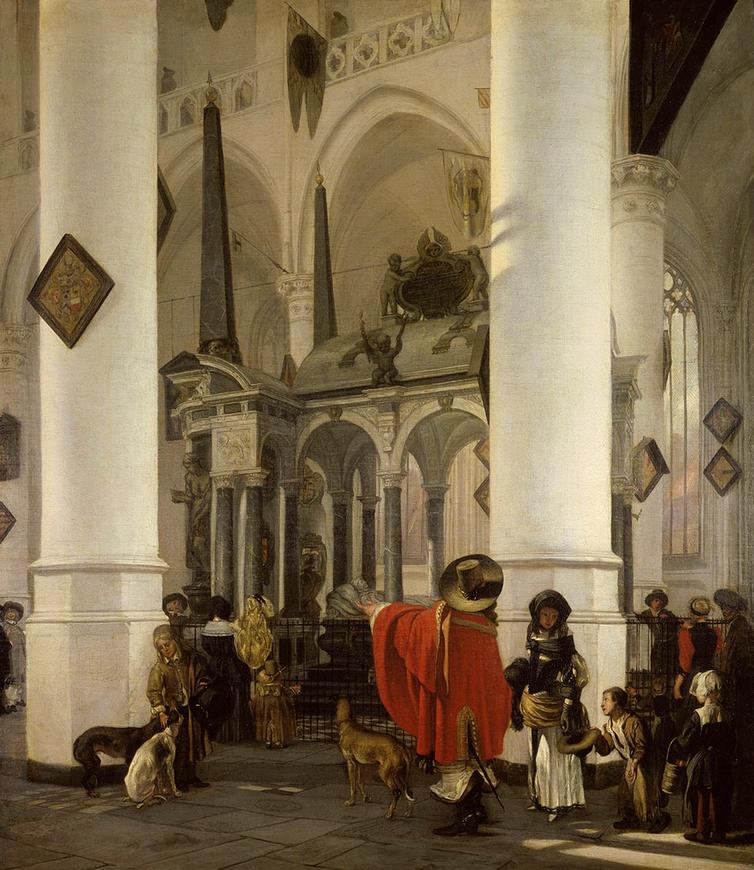A special guide, whose face remains unknown to us, welcomes us in this very lively church. He is represented from behind and with hand outstretched, indicating towards the centre of the painting, marked by the head of a recumbent. This is the statute of the tomb of William I, known as William the Taciturn, general governor of the United Provinces of the Netherlands.
Around this mysterious man dressed in a flamboyant red cape, a small group of ordinary people has gathered, reminiscent of genre painting. With the representation of the inside of churches – a very popular subject at this time – the genre painting was one of several pictorial genres adopted in the Dutch Golden Age. The elegantly dressed young woman pays little attention to the explanations given to her, preoccupied instead by a young boy asking her for charity. Scenes of charity are a common theme in paintings of the insides of churches.
This scene within a scene is observed by a little girl, holding a basket. On the other side, at the foot of the left column, a young boy strokes some dogs, often present in artist's representations. Other characters in the background animate the composition and give life to the painting.
In a somewhat oblique perspective, De Witte structures his composition via two columns framing the tomb. But what is most striking is his mastery of light! Blonde and diaphanous, it gives the entire composition a gentle and calm nature.
Detail 1 : The guided tour continues to find out more about this tomb! This is the final resting place of William the Taciturn (1533–1584) who lived in Delft, where he fought against the Spanish occupiers. He was assassinated at his residence in Prisenhof, in 1584, then buried in the New Church (Nieuwe Kerk). From then on, the Delft New Church became the burial place of the Royal Household. The tomb, a symbol of political independence and heroic sacrifice, was considered the most important national monument in the Dutch Republic!
Detail 2 : Excelling in the painting of figures and genre painting, De Witte inserts a red-caped character, with equal skill, in this alternative version of the Delft Nieuwe Kerk. The dogs, in familiar poses, bring a picturesque note to the majesty of the site (Los Angeles County Museum of Art).

A special guide, whose face remains unknown to us, welcomes us in this very lively church. He is represented from behind and with hand outstretched, indicating towards the centre of the painting, marked by the head of a recumbent. This is the statute of the tomb of William I, known as William the Taciturn, general governor of the United Provinces of the Netherlands.
Around this mysterious man dressed in a flamboyant red cape, a small group of ordinary people has gathered, reminiscent of genre painting. With the representation of the inside of churches – a very popular subject at this time – the genre painting was one of several pictorial genres adopted in the Dutch Golden Age. The elegantly dressed young woman pays little attention to the explanations given to her, preoccupied instead by a young boy asking her for charity. Scenes of charity are a common theme in paintings of the insides of churches.
This scene within a scene is observed by a little girl, holding a basket. On the other side, at the foot of the left column, a young boy strokes some dogs, often present in artist's representations. Other characters in the background animate the composition and give life to the painting.
In a somewhat oblique perspective, De Witte structures his composition via two columns framing the tomb. But what is most striking is his mastery of light! Blonde and diaphanous, it gives the entire composition a gentle and calm nature.
Detail 1 : The guided tour continues to find out more about this tomb! This is the final resting place of William the Taciturn (1533–1584) who lived in Delft, where he fought against the Spanish occupiers. He was assassinated at his residence in Prisenhof, in 1584, then buried in the New Church (Nieuwe Kerk). From then on, the Delft New Church became the burial place of the Royal Household. The tomb, a symbol of political independence and heroic sacrifice, was considered the most important national monument in the Dutch Republic!
Detail 2 : Excelling in the painting of figures and genre painting, De Witte inserts a red-caped character, with equal skill, in this alternative version of the Delft Nieuwe Kerk. The dogs, in familiar poses, bring a picturesque note to the majesty of the site (Los Angeles County Museum of Art).